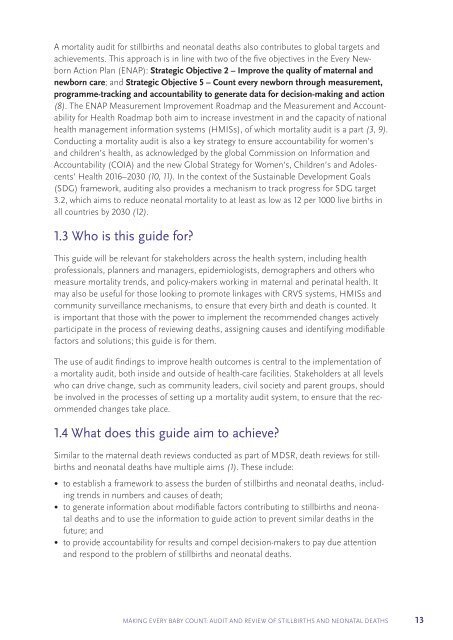Making Every Baby Count
9789241511223-eng
9789241511223-eng
Create successful ePaper yourself
Turn your PDF publications into a flip-book with our unique Google optimized e-Paper software.
A mortality audit for stillbirths and neonatal deaths also contributes to global targets and<br />
achievements. This approach is in line with two of the five objectives in the <strong>Every</strong> Newborn<br />
Action Plan (ENAP): Strategic Objective 2 – Improve the quality of maternal and<br />
newborn care; and Strategic Objective 5 – <strong>Count</strong> every newborn through measurement,<br />
programme-tracking and accountability to generate data for decision-making and action<br />
(8). The ENAP Measurement Improvement Roadmap and the Measurement and Accountability<br />
for Health Roadmap both aim to increase investment in and the capacity of national<br />
health management information systems (HMISs), of which mortality audit is a part (3, 9).<br />
Conducting a mortality audit is also a key strategy to ensure accountability for women’s<br />
and children’s health, as acknowledged by the global Commission on Information and<br />
Accountability (COIA) and the new Global Strategy for Women’s, Children’s and Adolescents’<br />
Health 2016–2030 (10, 11). In the context of the Sustainable Development Goals<br />
(SDG) framework, auditing also provides a mechanism to track progress for SDG target<br />
3.2, which aims to reduce neonatal mortality to at least as low as 12 per 1000 live births in<br />
all countries by 2030 (12).<br />
1.3 Who is this guide for?<br />
This guide will be relevant for stakeholders across the health system, including health<br />
professionals, planners and managers, epidemiologists, demographers and others who<br />
measure mortality trends, and policy-makers working in maternal and perinatal health. It<br />
may also be useful for those looking to promote linkages with CRVS systems, HMISs and<br />
community surveillance mechanisms, to ensure that every birth and death is counted. It<br />
is important that those with the power to implement the recommended changes actively<br />
participate in the process of reviewing deaths, assigning causes and identifying modifiable<br />
factors and solutions; this guide is for them.<br />
The use of audit findings to improve health outcomes is central to the implementation of<br />
a mortality audit, both inside and outside of health-care facilities. Stakeholders at all levels<br />
who can drive change, such as community leaders, civil society and parent groups, should<br />
be involved in the processes of setting up a mortality audit system, to ensure that the recommended<br />
changes take place.<br />
1.4 What does this guide aim to achieve?<br />
Similar to the maternal death reviews conducted as part of MDSR, death reviews for stillbirths<br />
and neonatal deaths have multiple aims (1). These include:<br />
• to establish a framework to assess the burden of stillbirths and neonatal deaths, including<br />
trends in numbers and causes of death;<br />
• to generate information about modifiable factors contributing to stillbirths and neonatal<br />
deaths and to use the information to guide action to prevent similar deaths in the<br />
future; and<br />
• to provide accountability for results and compel decision-makers to pay due attention<br />
and respond to the problem of stillbirths and neonatal deaths.<br />
MAKING EVERY BABY COUNT: AUDIT AND REVIEW OF STILLBIRTHS AND NEONATAL DEATHS<br />
13
















